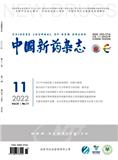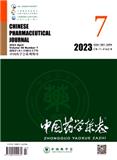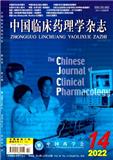
中国天然药物(英文版)(Chinese Journal of Natural Medicines) 知网万方目次维普目次
- CSCD
- 科核
- 主管单位:
中华人民共和国教育部
- 主办单位:
中国药科大学;中国药学会
- 国际刊号:
2095-6975;EISSN1875-5364
- 国内刊号:
32-1845/R
- 学科分类:
- 字数:
12000-38000
- 有无基金:
/有基金 100.0%
- 周期:
CN外文-月刊
- 特殊属性:
第二批认定学术期刊
- 电话:
025-83271565;83271568(202105期)
- 邮箱:
cjnm@cpu.edu.cncpucjnm@163.com(202105期)
- 复合因子:
1.986
- 综合因子:
1.388
- 收录:
知网,万方目次,维普目次
- 级别:
CSCD,科核
期刊简介
《中国天然药物》期刊已被查看: 次
更新频次
单位占比
一作占比
/有基金-100.0%投稿指南
1、投稿方式:在线投稿。
2、刊内网址:http://www.cjnmcpu.com/
投稿系统:
http://mc03.manuscriptcentral.com/cjnm
http://www.sciencedirect.com/science/journal/18755364
3、刊内邮箱:cjnm@cpu.edu.cn
cpucjnm@163.com
4、刊内电话:025-83271565;83271568
5、出刊日期:月刊,每月20日出版。
6、刊内微信公众号:中国天然药物杂志
2021年5月19日星期三
《中国天然药物(英文)》投稿须知
【官网信息】
INSTRUCTIONS FOR AUTHORS
Chinese
Journal of Natural Medicines (CJNM, ISSN 2095-6975, original ISSN
1672-3651) was founded in May 2003 and is sponsored by China
Pharmaceutical University and Chinese Pharmaceutical Association. The
printed version of CJNM is published monthly by Science Press and its
web edition is published by Elsevier. CJNM is devoted to communications
among pharmaceutical and medicinal plant scientists who are interested
in the advancement of the botanical, chemical, and biological sciences
related to natural medicines, including traditional Chinese medicines
(TCM). CJNM aims to cover a broad spectrum of original research papers
and timely review articles in natural medicines and their products from
all over the world. All the articles of CJNM are published in English
only. The journal is currently indexed by SCIE, MEDLINE, BIOSIS
Previews, BIOSIS Toxicology, CAB Abstracts, EMBASE, EMBASE Alert, Global
Health, IPA, IPA Toxicology, SCOPUS, SciFinder Scholar, ScienceDirect,
Biological Abstracts, Chemical Abstracts, Elsevier Bibliographic
Databases, Excerpta Medica, and Index Copernicus. CJNM is also indexed
by Chinese Science Citation Database (CSCD).
SCOPE
● Resources, biodiversity, conservation, sustainability, and quality control of natural medicines and natural products
● Modernization of natural medicines
●
Natural product chemistry (including structure determination and
modification, semi- and total synthesis, and bio-transformation)
●
Biological, pharmacological, and clinical evaluation of natural
products and traditional medicine prescriptions (including
pharmacokinetics, pharmacodynamics, efficacy, and toxicology)
● Pharmaceutics and analytical chemistry of natural medicines and natural products
● Proteomic, genetic, genomic, and metabolomic studies of natural medicines and natural products
●
Botanical, chemical, and biological techniques and methodologies for
the research and development (R & D) of natural medicines and
natural products
● National and international regulations concerning traditional medicines and botanical drug products
TYPES OF ARTICLES
● Original research papers
● Review articles (mini review and comprehensive review)
● Perspectives (commentary and letter to editor)
● Short communications (original research)
● Editorials
BASIC RULES FOR PUBLICATION
Manuscripts will only be considered for publication in CJNM if the following conditions, as applicable, are fulfilled:
1.
Ethical considerations: Manuscripts are accepted for consideration with
the understanding that they have not been published or submitted or are
under consideration for publication elsewhere. Authors investigating
the chemistry of a single species should aim to publish their results in
a single manuscript rather than in a series of papers. Manuscripts
should not report fragmentary parts of a larger study. Papers that have
been presented as proceedings at scientific meetings are acceptable.
Ethical standards with respect to the acquisition of studied materials,
chemical and biological hazards, animal use and care, and human subjects
must be strictly followed. Evidence of assurance to ethical standards
may be presented by the authors, or may be required by the
Editor-in-Chief of CJNM. For studies involving experimental animals,
reference must be made to principles of laboratory animal care or
similar regulations and to the specific approval of the described study
protocol by a local ethical committee. The approval number and the
corresponding date must be provided.
2.
Plant materials (and other organisms): Samples should be properly
identified and their location and date of origin given. The scientific
name (in italics) of the organism, the author of the name, and the
family must be given. It should be indicated who identified and
authenticated the materials used in the study and his/her affiliation.
The manuscript must include details of voucher specimens of the plant
material (deposited in a major national or regional herbarium).
3.
Isolation of compounds: Only new compounds with biological activity
will be considered for publication. The submission of articles
describing the isolation of known compounds, or the determination of a
simple derivative of a known compound is not acceptable. Extraction and
isolation procedures should be described in detail. The type and amount
of materials, solvents, and extraction methods must be indicated. The
description of chromatographic systems should contain the quantitative
information and all analytical conditions such as column dimensions,
mobile phase, elution program, fraction size, and yields of all
isolates.
4.
Biological, pharmacological, and clinical investigations of extracts:
The detailed extract characterization should be included. Spectroscopic
(e.g., NMR or mass) and/or chromatographic profiling (e.g., HPLC profile
with at least the major peaks identified) should be included;
qualitative and quantitative information on the active or typical
constituents should be provided. The investigation must clearly indicate
concentration/dose-activity dependence in comparison with a reference
compound (positive control).
5.
Biological screening: Papers dealing with the biological screening of a
meaningful number of extracts of plants or other organisms can be
considered for publication. Identification of the materials tested must
be properly documented, and preparation of the extracts must be clearly
described. Biological activities for extracts and compounds should be
reported by listing IC50 values, or at least a dose-response
relationship as shown by using at least two test concentrations.
Positive controls (reference compounds) must be included for all
biological studies. Classification of “active” and “inactive” samples
should follow accepted international standards for the biological test
system.
6.
Analytical studies: Key data on method validation must be provided and
should typically include information on specificity, linearity, limit of
detection, limit of quantification, accuracy, precision, intermediate
precision, and robustness studies. Information on the purity of
reference compounds and the methods used for the determination of purity
must be given. Recoveries of extraction and sample pre-purification
steps must be indicated. Adequate statistical analysis is required.
Analytical studies of a routine nature will not be considered for
publication.
7.
Clinical studies: All clinical trials must be designed, implemented,
and analyzed in a manner to meet current international standards,
especially for randomized controlled trials. Reference must be made to
approval of the study by a local ethical committee for human subject
research. The approval number and the corresponding dates of the
approved trial must be provided. All clinical trials should be
appropriately registered in an international database (www.
clinicaltrials.gov). The registration information must be provided.
LANGUAGE AND MANUSCRIPT CONTENTS
1. Language
English
is the language for all manuscripts published in CJNM. If English is
not the native language of the authors, it is author’s responsibility to
enlist the help of an English-speaking colleague for the correct use of
the language throughout the manuscript before submission. Manuscripts
with poor language quality will be returned to authors without review.
2. Manuscript contents
Manuscripts
must be prepared using Microsoft Word for easy re-formatting and
modification and should contain the following sections as appropriate:
Title, Authors and Affiliations, Abstract, Keywords, Introduction,
Materials and Methods, Results, Discussion, Acknowledgements, Conflict
of Interest, and References.
The
first /Title page must contain: manuscript title, author(s) name and
affiliation(s). The name, full postal address, telephone and FAX
numbers, and e-mail address of the corresponding author(s) should be
clearly indicated.
1)
Title: The title of a manuscript should describe the key content of the
article clearly and precisely. The use of expressions with little
information, such as “a study of”, “investigations of”, and
“observations on,” and non-standard abbreviations should be avoided. The
authors are encouraged to use terms in the title which facilitate the
potential readers to search and read the paper.
2)
Authors: The full name(s) of the author(s) should be provided. Only
those scientists who have made an intellectual contribution to the work
should be included in the author list. All authors must approve the
final version of the manuscript. The corresponding author(s) should be
indicated with an asterisk. Only one contact corresponding author should
be identified for communication with the editorial office of the
journal.
3)
Abstract: The abstract should NOT include references to figures,
tables, equations, any other materials in the main text or literature
reference. The Abstract section should be less than 250 words. = The
major contents of the Abstract section should include key information on
the background and objective, methods, results, and conclusion of the
presented study, without subheading. The authors are encouraged to use
terms in the Abstract section which facilitate the potential readers to
search and read the paper.
4) Keywords: It should include 5−8
keywords. The appropriate choice of keywords may increase the
visibility of the article. The authors are encouraged to use terms in
the Keywords section which facilitate the potential readers to search
and read the paper.
5)
Introduction: The Introduction section should be brief and
comprehensive. It should clearly state the background, the rationale of
the study, the hypothesis being tested, and the novelty and significance
of the study. The list of results in the Introduction section should be
avoided.
6)
Materials and Methods: This section should provide sufficient details
to allow experienced readers to repeat the experiments, if necessary.
Plant species must be authenticated by an expert botanist. Information
regarding solvents and chemical reagents should include manufacturer,
grade and batch number. It is also required to indicate the species,
strains, and source of the animals used, and the conditions under which
the animals were housed and maintained. Vendor information should be
provided for all instruments, materials, and supplies. Experimental
methods should be properly described and referenced.
7)
Results: The Results section should be concisely presented and
explicitly explained, with the appropriate use of figures (more than 600
dpi pixels) and tables. Confidence in the data generated from the
experiment will be increased by the validation of the methodology and
logical elaboration of the new findings on which the value of the study
relies. Statistical results should be indicated in the figures and
tables. Figure and table legends should include sufficient information
to help readers understand the results presented.
8)
Discussion: This section gives the authors an opportunity to discuss
how the results contribute to the knowledge and development of a
specific subject, or more broadly in a given field of science or
technology. New hypotheses and speculations must be substantiated by the
results presented. The length of the Discussion section should be kept
to a minimum. The key points should be referenced.
9)
Acknowledgements: This section contains research sponsor information
and the acknowledgement of the contribution made by those not listed as
authors, including analytical services and manuscript preparation.
10)
Conflict of Interest: This section contains information on potential
competing interests the authors may have. A full disclosure is required.
11)
References: Authors should follow the examples given below for the
format of references. References to unpublished data or personal
communications should be avoided.
3. Figures
High
quality figures should be provided with the following characteristics.
They should be produced in resolution of 600 dpi and have lines,
letters, numbers and symbols of uniform strength and contrast. Figures
(except photographs) are often reduced to 8 cm × 8 cm. The final
thickness of a line in a figure usually lies within the range 0.15−0.20 mm or 1.5 pb. When preparing the figures, authors should pay attention to the widths
of lines and similar details, as some (e.g., dotted or thin lines) may
disappear after reduction. Particular attention should be paid to line
strengths in graphics prepared in vector formats. And all the structures
must be optimized by “ChemDraw CS96” software. All the figures should
be cited in the main text in a logical order.
REFERENCE EXAMPLES
Books:
State Administration of Traditional Chinese Medicine. Zhonghuabencao
[M]. Shanghai Science and Technology Publishing Company, 1999: 931-934.
Journals: Jiang MY, Zhang L, Liu R, et al. Speciosins A−K, oxygenated cyclohexanoids from the basidiomycete Hexagonia speciosa [J]. J Nat Prod, 2009, 72 (8): 1405-1409.
Patents: Tachibana R, Shimizu S, Kobayshi S, et al. Electronic water marking method and system: US, 6,915,001 [P]. 2002-04-25.
Standards: Pharmacopoeia of the Peoples Republic of China (2005). Vol 2 [S]. 2005: 44.
E-references: Wikimedia. Trichilia [EB/OL]. 2010: http://species.wikimedia.org/wiki/Trichilia
MANUSCRIPT/FILE SUBMISSION
Authors must submit manuscripts to
http://mc03.manuscriptcentral.com/cjnm
Authors need to provide a simple research highlight about the manuscript after it is accepted by CJNM.
PEER REVIEW AND REVISION OF MANUSCRIPTS
Manuscripts
will be reviewed by CJNM editors and at least two anonymous referees
who are experts in the related field. Should revision become necessary,
the manuscript, with the comments of the referee(s), will be returned to
the author(s). Revised manuscripts are usually required to be sent back
to the editorial office within two months. The editorial office
reserves the right to make changes to any aspect of the manuscript, in
order to enhance the clarity of the presentation.
PAYMENT OF MANUSCRIPTS
The
author will be responsible for the following expenses with respect to
consideration and publication of the submitted manuscript.
◆
At the time of submission, the expenses of the ScholarOne manuscript
system and of the review: $ 50 for each manuscript submission
◆
After acceptance by the CJNM, the expenses of polishing and improving
the language of the manuscript by an international professional, if
requested by the Editor: $300 for each manuscript. The Author may also
seek external assistance for language enhancement, and indicate so to
the Editor at the time of resubmission.
◆ Publication of accepted paper: , page charges of $ 120 for each printed page.
◆ Payments should be made in a timely manner to:
◆ ser name: China Pharmaceutical University
Account number: 4301011019001029831
SWIFT BIC(s): ICBKCNBJNJG
◆ Please note that any delay in payment will result in a subsequent delay in publication.
COPYRIGHT
The
copyright of all papers published in CJNM belongs to China
Pharmaceutical University, Nanjing, China. A copyright transfer form
must be filled by the authors and returned to the Editorial Office of
CJNM before acceptance of the paper.
上一篇:中国性科学下一篇:舰船电子工程(原:舰船指挥控制系统)
《中国天然药物》同类药学期刊
-

药学学报
北核,CSCD,科核,武A+
CN中文-月刊影响因子2.553
-

中国新药杂志
北核,CSCD,科核,武A
CN中文-半月刊影响因子1.443
-

中国药学杂志
北核,CSCD,科核,武A-
CN中文-半月刊影响因子1.392
-

中国药理学通报
北核,CSCD,科核,武A+
CN中文-月刊影响因子2.322
-

中国抗生素杂志
北核,CSCD,科核,武A-
CN中文-月刊影响因子1.596
-

中国临床药理学杂志
北核,CSCD,科核,武A+
CN中文-半月刊影响因子1.499
-

中国药理学与毒理学杂志(不收版面费审稿费)
北核,科核,武A
CN中文-月刊影响因子1.087
-

中国药房
北核,科核,武A
CN中文-半月刊影响因子2.197
常见问题
-
中国天然药物杂志社官网、联系方式是什么?
中国天然药物杂志社官网:http://www.cjnmcpu.com/
投稿网址:http://mc03.manuscriptcentral.com/cjnm联系电话:025-83271565;83271568(202105期)
投稿邮箱:cjnm@cpu.edu.cncpucjnm@163.com(202105期) -
中国天然药物杂志是核心期刊么?
中国天然药物是核心期刊,级别是:CSCD,科核, 是:药学分类下的知网,万方目次,维普目次收录的期刊。
-
请问你们是中国天然药物杂志社吗?
我们不是《中国天然药物》杂志社。本站主要从事期刊信息展示与期刊推荐,不是任何杂志官网,直投稿件请联系杂志社。本站仅提供免费的学术指导、论文辅导、期刊投稿信息整理收集服务。
-
你们指导服务后可以保证文章被发表吗?
期刊发表的成功与否,主要取决于文章内容的质量。编辑老师会根据研究领域、创新性等多因素进行考量。我们会帮助您理解期刊的发表要求,助力提升发表几率,从而增加发表的机会。
-
晋级论文能否在报纸上发表?
在学术界,论文的发表往往被视为研究者职业发展的重要一环。晋级论文,即为了获得更高职称或学术地位而撰写的学术论文,通常需在专业期刊上发表。然而,许多人可能会问
